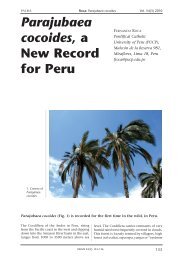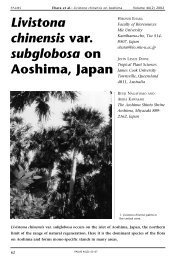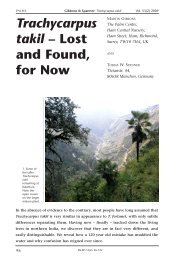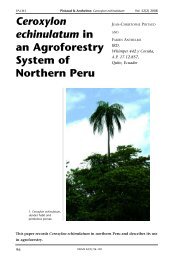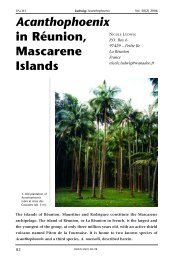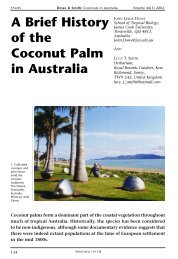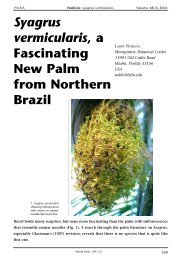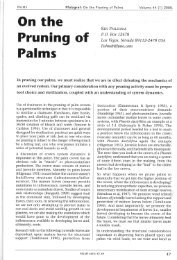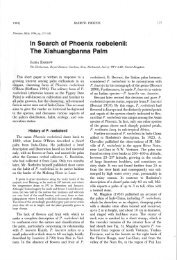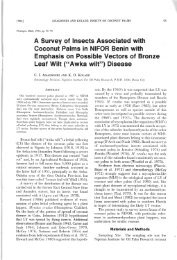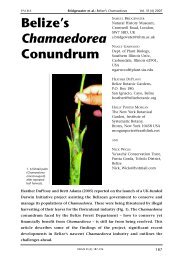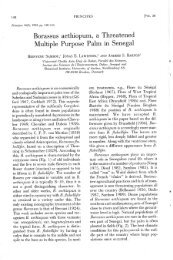The Genus Heterospsthe in Cultivation - International Palm Society
The Genus Heterospsthe in Cultivation - International Palm Society
The Genus Heterospsthe in Cultivation - International Palm Society
Create successful ePaper yourself
Turn your PDF publications into a flip-book with our unique Google optimized e-Paper software.
PALMS<br />
Migfiaccio: Heterospathe <strong>in</strong> cultivation Volume 45(1) 200<br />
comm.). Unfortunately, it is restricted to one<br />
population of 400-500 adults on the island of Vitu<br />
Levu <strong>in</strong> an area selectively logged for its<br />
hardwoods. Accord<strong>in</strong>gly, it has been proposed as<br />
a Threatened Species - the only member of the<br />
genus considered for a special conservation<br />
consideration (Fuller & Doyle 1997). Fortunately,<br />
seeds of this palm are cultivated <strong>in</strong> a few private<br />
gardens <strong>in</strong> Suva, Fiji and have been distributed<br />
widely to botanical gardens and collectors <strong>in</strong><br />
Hawaii, Australia and Florida.<br />
Heterospathe scitula is an exceptionally attractive<br />
cluster<strong>in</strong>g species similar to H. philipp<strong>in</strong>ensis but<br />
with fewer leaflets of variable width. Young leaves<br />
are reddish-brourn and trunks are slender - mak<strong>in</strong>g<br />
this species also well-suited to conta<strong>in</strong>er culture.<br />
However, many seedl<strong>in</strong>gs succumbed to fungal<br />
<strong>in</strong>fections dur<strong>in</strong>g the cool w<strong>in</strong>ter (two nights of<br />
4"C m<strong>in</strong>imum temperature) <strong>in</strong> South Florida<br />
Interest<strong>in</strong>gly, despite the fact that FL sibuyanensis<br />
has been occasionally cultivated for many years <strong>in</strong><br />
Australia, Hawaii and Florida, specimens have not<br />
been collected <strong>in</strong> the wild s<strong>in</strong>ce the orig<strong>in</strong>al<br />
description <strong>in</strong> 1919 (Fernando 1990). Recent<br />
searches on the island of Sibuyan, Philipp<strong>in</strong>es have<br />
not turned up any <strong>in</strong>dividuals of this species, so<br />
collectors should be wary of seeds or plants with<br />
this name, particularly because this species closely<br />
resembles H. elata.<br />
Heterospathe woodfordiana, with its rich red new<br />
leaves, is another species worthy of wider use <strong>in</strong><br />
the landscape. It has been more widely used <strong>in</strong><br />
Australia and Hawaii as an accent palm but with<br />
some care, should also be able to be grown<br />
successfully <strong>in</strong> South Florida. Despite its beauty, its<br />
slow rate of growth and the lack of any regular<br />
seed source reduces its chances of wider landscape<br />
use.<br />
<strong>The</strong> newly <strong>in</strong>troduced H. brevicaulls and Il.<br />
<strong>in</strong>termedia are now be<strong>in</strong>g cultivated <strong>in</strong> Australia,<br />
Hawaii, and South Florida but little is knor,rrn about<br />
their grow<strong>in</strong>g requirements or ultimate horticultural<br />
potential.<br />
Cultivat<strong>in</strong>g H etero sp athe<br />
Because most species are found <strong>in</strong> primary<br />
ra<strong>in</strong>forests, conditions of high humidity and acidic<br />
soils (or pott<strong>in</strong>g media) will promote the best<br />
growth. If it is difficult to provide these conditions<br />
<strong>in</strong> the landscape, long term conta<strong>in</strong>er culture may<br />
be a viable option. Growers <strong>in</strong> subtropical regions<br />
will also need to provide cold protection, especially<br />
from dry w<strong>in</strong>ds. Based on what is known now,<br />
this genus prefers filtered light <strong>in</strong> protected<br />
locations. <strong>The</strong> only exception is H. elata which<br />
flourishes <strong>in</strong> full sun. Regular applications of a<br />
balanced palm fertilizer and micronutrient sprays<br />
will also promote growth and strengthen plants<br />
aga<strong>in</strong>st conditions of low humidity and<br />
temperature. Patience is also a requirement for<br />
grow<strong>in</strong>g palms <strong>in</strong> this genus as most are slowgrow<strong>in</strong>g.<br />
Many species have new leaves rang<strong>in</strong>g <strong>in</strong> color<br />
from p<strong>in</strong>k-bronze, to deep red to orange-red, so<br />
that even as juveniles <strong>in</strong> pots, they provide a<br />
welcome splash of color <strong>in</strong> the nursery.<br />
Many Questions Rema<strong>in</strong><br />
Despite recent collect<strong>in</strong>g activity <strong>in</strong> the Southwest<br />
Pacific, the follow<strong>in</strong>g species rema<strong>in</strong> poorly known<br />
or unknown <strong>in</strong> cultivation; H. annectens, a<br />
medium-sized solitary understory species with<br />
hairy leaf sheaths from Papua New Gu<strong>in</strong>ea; H.<br />
arfakiana from Irian Jaya, H. clemensiae, a 6 m tall<br />
solitary species found at 1800m elevation <strong>in</strong><br />
northeastern New Gu<strong>in</strong>ea; H. dransfieldii, a<br />
cluster<strong>in</strong>g, slender-trunked dwarf species endemic<br />
to the island of Palawan, Philipp<strong>in</strong>es; H. glabra, a<br />
solitary palm from 1800 m elevation <strong>in</strong> New<br />
Gu<strong>in</strong>ea; H. kajewskii, a 15 m tall solitary species<br />
with 2.5m long fronds found at 1000m elevation<br />
on the island of Bouga<strong>in</strong>ville, Solomon Islands; I{.<br />
Iedermanniana from New Gu<strong>in</strong>ea; H. Iepidota, a<br />
solitary palm to 6 m tall from lowland slopes <strong>in</strong><br />
Papua New Gu<strong>in</strong>ea; H. macyegori, a rheophyte<br />
from Papua New Gu<strong>in</strong>ea (see Back Cover); 11.<br />
mullerana, a large-fruited species from the Eastern<br />
Highlands of Papua New Gu<strong>in</strong>ea at 1600-2000<br />
m), H. obriensis, also from the Eastern Highlands<br />
of Papua New Gu<strong>in</strong>ea; the attractive H. parviflora<br />
from the tropical New Brita<strong>in</strong> Islands of Papua<br />
New Gu<strong>in</strong>ea, H. pilosa from the Cyclops Mounta<strong>in</strong>s<br />
of New Gu<strong>in</strong>e4 H. pulchra from Papua New<br />
Gu<strong>in</strong>ea and called "exceptional" by Moore; H.<br />
rqmulosa with a 6 cm stem from Bouga<strong>in</strong>ville <strong>in</strong><br />
the Solomon Islands; H. sensisi, a 15-20 m solitary<br />
species from the Solomon Islands; H. sphaerocarpa,<br />
an acaulescent species with 4.5 m long fronds<br />
from 1200m elevation <strong>in</strong> the Central Division,<br />
Papua New Gu<strong>in</strong>ea; H. trispatha, a slender<br />
understory palm endemic to lowland dipterocarp<br />
forests on the island:,of Luzon, Philipp<strong>in</strong>es; IL<br />
uniformis, a 7 m solitary species endemic to<br />
lowland forests on West Ambrym, Vanuatu; and<br />
H. versteegiana from New Gu<strong>in</strong>ea<br />
Summary<br />
As more species of Heterospathe are cultivated, it<br />
is hoped that commercial growers and collectors<br />
will share their experiences so that these attractive<br />
palms will f<strong>in</strong>d greater use <strong>in</strong> landscapes and that<br />
ex situ conservation efforts for taxa such as I{.<br />
phillipsii can cont<strong>in</strong>ue to buffer the effects of<br />
widespread deforestation <strong>in</strong> the Southwest Pacific.<br />
20



